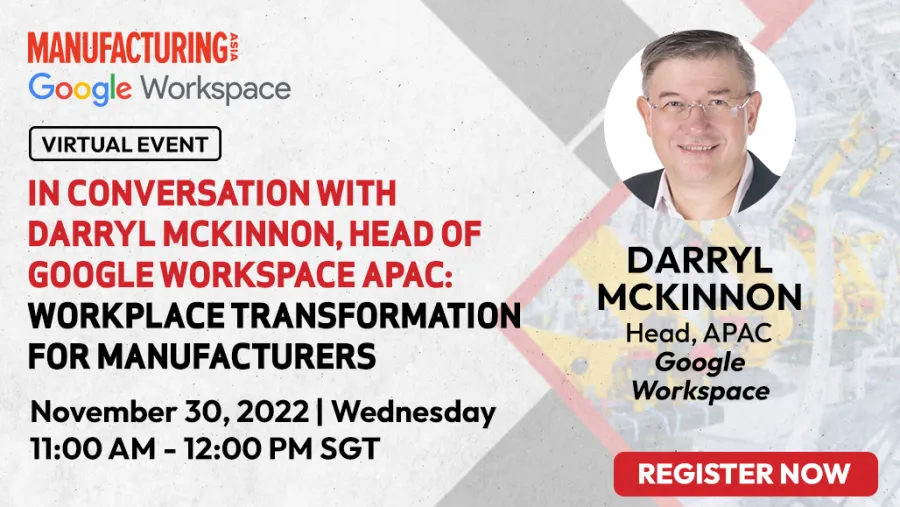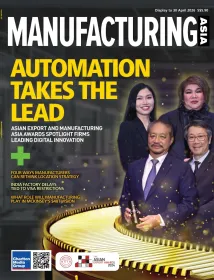
Transforming the Manufacturing Industry through Digital Collaboration
Google Workspace enables connections in a safe, cloud-first environment.
Markets, industries, and businesses of all sizes are today evolving digitally to remain competitive. A report by Deloitte, however, has revealed that many manufacturing organisations are behind in the digital transformation race, specifically in enterprise-wide initiatives such as customer-related innovation and human resources, even whilst analytics- and artificial intelligence-driven technologies have emerged.
Antiquated technologies in network infrastructure, hardware, and software continue to be used across the business, bringing about a gamut of issues related to maintenance, incompatibility with modern cloud-based solutions, weak security, and poor employee collaboration and customer service.
The Human Challenge
Part of the challenge is acquiring new skill sets amongst employees and hiring people with the right skills, said Darryl McKinnon, Head of Google Workspace APAC, Google Cloud, in an interview with Manufacturing Asia. “When you introduce digital transformation, you may be introducing new tools. Do they have the right skills to deal with the complexities of deploying if it's on-premises? Can they move to the cloud?
“And how do they get those individuals to start adopting that technology, which always leads to change management, and do that at the lowest cost possible? So those are the big challenges we see around digital transformation.”
Whilst manufacturers are doing all these, they are also dealing with supply chain volatility on the back of COVID-19, McKinnon said.
Seeing the Benefits of Digital Transformation
Modernising manufacturing systems might be complicated and time-consuming, but it also sharpens their competitive edge, improves employee performance and engagement, tightens security, and enables data to support decisions, which eventually grows the business.
This is the kind of solution that Google Workspace brings to manufacturing organisations, McKinnon explains. Google Workspace, a suite of collaboration tools, offers “all of the advantages and benefits that Google Cloud is built on.” McKinnon specifies the benefits of Google Workspace across the enterprise silos:
Operations
Google Workspace carries tools and technologies that make it easier for the enterprise to quickly connect and communicate across production lines and suppliers, and to optimise operations. From standard meetings to training, the tool can gather people on-site or virtually.
The company has even updated Google Glass to make it relevant to remote training, said McKinnon, explaining that it can be used “when they're having to provide a service or a piece of equipment, or they're looking where something might be broken or run down.”
Production And innovation
Google Meet allows people to connect very quickly, with the bonus of recording the conversation.
“You can then put that conversation into a doc, quickly jump into that in real-time, and collaborate with each other on the changes you want to make, whether it's a project plan or a design specification.”
A unique aspect of Google Workspace is AppSheet, which allows workers involved in a project to automate a paper-based or manual process, using a no-code development approach.
“We see opportunities in the workplace to allow workers to become digital workers, as well as foster an environment where people can very quickly collaborate, driving innovation,” he said.
Corporate-to-Shop Floor Collaboration, Vendors and Suppliers
Corporate headquarters and the shop floor are usually situated in different locations, but with Google Workspace, connecting the two units can be easily done through video meetings on any device whilst consuming low bandwidth. Remote meetings can be done one-on-one or by joining rooms with multiple staff members. McKinnon revealed that teams can even launch a meeting from inside documents.
“You could be in the U.S. looking at a spreadsheet that's got a project plan, then launch from that a video call in real time involving all the key stakeholders,” he said.
He added that the documents, slides, and sheets feature smart chips that allow users to embed any kind of regularly used data, whether it pertains to production, customers, or standard operating procedures. This eliminates the need to make a mad scramble for information every time it is needed.
"It's all embedded in these documents that are constantly shared between the remote offices and HQ. There are no 12 different versions. It's a single document that's actually updated and maintained in real-time.”
The smart chip technology can even have this data embedded around a supplier or a vendor, making it very easy for manufacturers to track the latest supply chain data whilst maintaining full security through encryption. The latest features, Data Loss Prevention and Zero Trust, show alerts that a user is about to share information with someone external to the organisation.
Employee Engagement and Retention
In manufacturing, people tend to think about being remote, an idea that nurtures the feeling of disconnection or exclusion from the organisation. The Google Workspace calendar enables team members to send meeting invites and connect with each other. “I can make a decision to go into the office or into that location. That's allowing employee engagement.”
A Secure Platform
Being cloud-first, Google WorkSpace uses a browser-based approach, making it “architecturally superior to using physical devices,” said McKinnon. This first layer of security means there is no need to constantly and manually update data and patches and eliminates the need for local devices, native apps, security, add-ons, or even email attachments.
“The second thing is approaching security with zero trust. We have built-in controls, encryption, and verification that actually enable employees to work from anywhere and eliminate the need for VPNs.”
Transforming Manufacturing with Google workspace
To help its enterprise users in manufacturing transition to a digital workplace, Google has invested heavily in enabling the users with knowledge, McKinnon said.
“We currently have over 3 billion users of Google Workspace,” he said. The platform can be operated from a single dashboard, then seamlessly integrated into a variety of tools from Adobe, Salesforce, DocuSign, or a manufacturing ERP application, removing the need to constantly toggle between applications.
“The biggest users in manufacturing, the frontline, are looking for their most used applications in a single dashboard, where they could create a quick meeting, make a call, or send a response or an update. Where they're in a safe environment that allows innovation and collaboration.”
The manufacturing industry often relies on tried and tested operational methods, however with the right application of technology and integration of all work processes into one platform innovation and efficiency can still skyrocket creating more value for a days work.

















